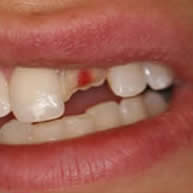The desire for a brighter, whiter smile is one that has been present long before there was a written history. There is evidence that as early as 3000 BCE, people used sticks to clean their teeth. The earliest evidence of toothbrushes are those made of animal hair in the mid 1400s. This indicates a real value to possessing a healthy, winning smile.
The earliest examples of teeth whitening occur with the ancient Egyptians, who whitened their teeth using a paste made of finely ground pumice stone and vinegar. This mild abrasive removed surface stains from teeth and is very similar to many abrasive properties held by whitening toothpastes today.
Ancient Romans recognized that ammonia, generated by urine left to break down, would whiten teeth. This practice was extremely common and was present in some form or another until the late 1600s. Urine was also used to clean, and to brighten and whiten clothes and was considered a commodity in ancient Rome, to the point where it was taxed by one emperor.
Teeth whitening began with barbers in the 1700s. They doubled as dental surgeons, mostly extracting decayed and painful teeth. These barbers would file down teeth and then apply nitric acid to whiten them, leaving teeth shiny and bright, unfortunately not knowing that this would lead to damaged tooth enamel and later to decay and infection.
Today, teeth whitening can be done at home or in a dentist’s office. Whitening treatments can utilize gels and laser lights that activate the bleaching agents in each gel. Some at-home treatments utilize trays or whitening strips and can include whitening toothpastes and mouth rinses.
Talk to your dentist if you have any questions about what methods of teeth whitening are best for you, or if you want any more information about your dental care.






